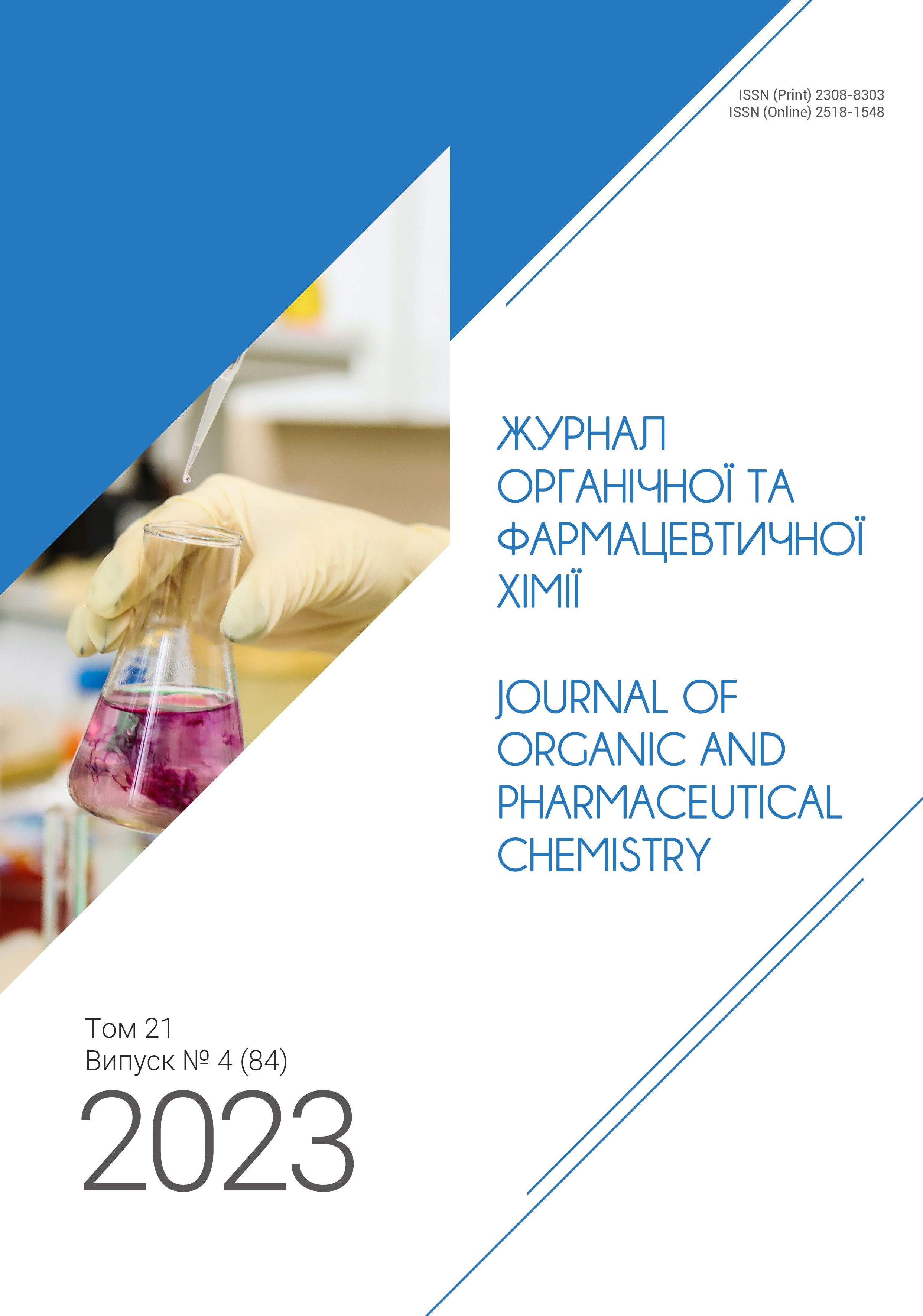Nature-Inspired Tetrahydropentalene Building Blocks: Scalable Synthesis for Medicinal Chemistry Needs
DOI:
https://doi.org/10.24959/ophcj.23.299612Keywords:
tetrahydropentalene, building blocks, medicinal chemistry, multigram synthesisAbstract
Inspired by the bioactivity of natural compounds with a bicyclo[3.3.0]octane core, the study focuses on developing tetrahydropentalene-2,5-dione (2,5-THP-dione) derivatives as potential building blocks for the use in medicinal chemistry. Using the commercially available 2,5-THP-dione, a number of alkylated derivatives and a monofunctional ketone were synthesized. Using optimized protocols for synthesis, target compounds were obtained with high yields on a multigram scale. These compounds are promising derivatives for further chemical derivatization and therapeutic use, and thus highlight the value of 2,5-THP-dione in creating complex molecular structures for drug discovery, as well as the importance of tetrahydropentalene derivatives as valuable building blocks in synthetic chemistry.
Supporting Agency
- The authors received no specific funding for this work.
Downloads
References
- Deimling, M.; Zens, A.; Park, N.; Hess, C.; Klenk, S.; Dilruba, Z.; Baro, A.; Laschat, S. Adventures and Detours in the Synthesis of Hydropentalenes. Synlett 2021, 32 (02), 119-139. https://doi.org/10.1055/s-0040-1707226.

- Cho, T. P.; Gang, L. Z.; Long, Y. F.; Yang, W.; Qian, W.; Lei, Z.; Jing, L. J.; Ying, F.; Ke, Y. P.; Ying, L.; Jun, F. Synthesis and biological evaluation of bicyclo[3.3.0] octane derivatives as dipeptidyl peptidase 4 inhibitors for the treatment of type 2 diabetes. Bioorg. Med. Chem. Lett. 2010, 20 (12), 3521-3525. https://doi.org/10.1016/j.bmcl.2010.04.138.
 |
| 
- Mitcheltree, M. J.; Li, D.; Achab, A.; Beard, A.; Chakravarthy, K.; Cheng, M.; Cho, H.; Eangoor, P.; Fan, P.; Gathiaka, S.; Kim, H.-Y.; Lesburg, C. A.; Lyons, T. W.; Martinot, T. A.; Miller, J. R.; McMinn, S.; O’Neil, J.; Palani, A.; Palte, R. L.; Saurí, J.; Sloman, D. L.; Zhang, H.; Cumming, J. N.; Fischer, C. Discovery and Optimization of Rationally Designed Bicyclic Inhibitors of Human Arginase to Enhance Cancer Immunotherapy. ACS Med. Chem. Lett. 2020, 11 (4), 582-588. https://doi.org/10.1021/acsmedchemlett.0c00058.
 |
| 
- Anderl, T.; Emo, M.; Laschat, S.; Baro, A.; Frey, W. Synthesis of Functionalized Pentalenes via Carbonyl-Ene Reaction and Enzymatic Kinetic Resolution. Synthesis 2008, 2008 (10), 1619-1627. https://doi.org/10.1055/s-2008-1067012.

- Kashima, H.; Kawashima, T.; Wakasugi, D.; Satoh, T. A method for synthesis of bicyclo[3.3.0]oct-1-en-3-ones from cyclobutanones with one-carbon ring expansion and its application to a formal synthesis of racemic 1-desoxyhypnophilin. Tetrahedron 2007, 63 (19), 3953-3963. https://doi.org/10.1016/j.tet.2007.03.019.

- Smyrnov, O. K.; Melnykov, K. P.; Rusanov, E. B.; Suikov, S. Y.; Pashenko, O. E.; Fokin, A. A.; Volochnyuk, D. M.; Ryabukhin, S. V. Multigram Synthesis of Dimethyl Stellane-1,5-Dicarboxylate as a Key Precursor for ortho-Benzene Mimics. Chem. Eur. J. 2023, 29 (70), e202302454. https://doi.org/10.1002/chem.202302454.
 |
| 
- Smyrnov, O.; Melnykov, K.; Pashenko, O.; Volochnyuk, D.; Ryabukhin, S. Stellane at the Forefront: Derivatization and Reactivity Studies of a Promising Saturated Bioisostere of ortho‐Substituted Benzenes. ChemRxiv 2024. https://doi.org/10.26434/chemrxiv-2024-rlf5q.
- Cadieux, J. A.; Buller, D. J.; Wilson, P. D. Versatile Route to centro-Substituted Triquinacene Derivatives: Synthesis of 10-Phenyltriquinacene. Org. Lett. 2003, 5 (21), 3983-3986. https://doi.org/10.1021/ol035546f.
 |
| 
- Piers, E.; Karunaratne, V. Bifunctional reagents in organic synthesis. Total syntheses of the sesquiterpenoids (±)-pentalenene and (±)-9-epi-pentalenene. Can. J. Chem. 1989, 67 (1), 160-164. https://doi.org/10.1139/v89-026.

- Piers, E.; Karunaratne, V. Methylenecyclopentane annulation: a synthesis of the sesquiterpenoid (±)-pentalenene. J. Chem. Soc., Chem. Commun. 1984, 15, 959-960. https://doi.org/10.1039/C39840000959.

- Pendiukh, V. V.; Yakovleva, H. V.; Stadniy, I. A.; Pashenko, A. E.; Rusanov, E. B.; Grabovaya, N. V.; Kolotilov, S. V.; Rozhenko, A. B.; Ryabukhin, S. V.; Volochnyuk, D. M. Practical Synthetic Method for Amino Acid-Derived Diazoketones Shelf-Stable Reagents for Organic Synthesis. Org. Process Res. Dev. 2024, 28 (1), 165-176. https://doi.org/10.1021/acs.oprd.3c00230.

- Leonard, J.; Bennett, L.; Mahmood, A. Synthesis of hirsutene — An approach involving asymmetric epoxide fragmentation. Tetrahedron Lett. 1999, 40 (20), 3965-3968. https://doi.org/10.1016/S0040-4039(99)00622-X.

- Wolff, L. Chemischen Institut der Universität Jena: Methode zum Ersatz des Sauerstoffatoms der Ketone und Aldehyde durch Wasserstoff. [Erste Abhandlung.]. Justus Liebigs Ann. Chem. 1912, 394 (1), 86-108. https://doi.org/10.1002/jlac.19123940107.

- Bodenschatz, K.; Stöckl, J.; Winterer, M.; Schobert, R. A synthetic approach to 5/5/6-polycyclic tetramate macrolactams of the discodermide type. Tetrahedron 2022, 104, 132113. https://doi.org/10.1016/j.tet.2021.132113.

Downloads
Additional Files
Published
How to Cite
Issue
Section
License
Copyright (c) 2024 National University of Pharmacy

This work is licensed under a Creative Commons Attribution 4.0 International License.
Authors publishing their works in the Journal of Organic and Pharmaceutical Chemistry agree with the following terms:
1. Authors retain copyright and grant the journal the right of the first publication of the work under Creative Commons Attribution License allowing everyone to distribute and re-use the published material if proper citation of the original publication is given.
2. Authors are able to enter into separate, additional contractual arrangements for the non-exclusive distribution of the journal’s published version of the work (e.g., post it to an institutional repository or publish it in a book) providing proper citation of the original publication.
3. Authors are permitted and encouraged to post their work online (e.g. in institutional repositories or on authors’ personal websites) prior to and during the submission process, as it can lead to productive exchanges, as well as earlier and greater citation of published work (see The Effect of Open Access).















